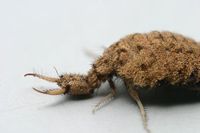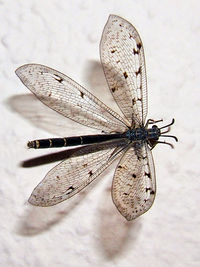On the Origin of Species: Trapinch, Vibrava and Flygon
|
A while ago I discussed the cicada, a curious little insect that spends most of its life in an immature phase underground, before emerging for a brief but highly conspicuous stint as a winged adult. Today's creature has a similar life cycle – a long immature phase followed by a short adult phase – but unlike the cicada, it's the larval form of this insect that most of us are familiar with.
Trapinch, Vibrava and Flygon stand out amongst Pokémon for a few reasons. They're insects – flying insects at that – but they have neither the Bug-type or the Flying-type. Trapinch has an extremely high Attack stat for a first-stage Pokémon – it's actually higher than that of its evolution, Vibrava. This, combined with its useful Arena Trap ability, means that Trapinch doesn't necessarily have to evolve in order to be useful in battle. Probably the most noticeable thing about this family, however, is the striking difference in appearance between Trapinch and its two evolutions. Vibrava and Flygon are green, winged insects, while Trapinch is a small, orange... thing.
Members of the same evolution family usually have some traits in common, or at least show some kind of logical progression from one phase to the next. Trapinch's dissimilarity to its relatives has attracted comment from the fandom, giving rise to a great deal of speculation. One fan theory even states that Trapinch was the original design of Charmander, based on its color and some early art of Charizard with a somewhat Trapinch-like mouth. But there is a logical explanation for these differences, reflected in the Trapinch family's inspiration: a group of insects that are as much myths as they are real creatures.
Antlions are a group of insects in the Myrmeleontidae family. There are at least 2,000 known species, but they all have certain features in common. Strictly speaking, the term 'antlion' refers only to their larval stage, but the English language doesn't actually have an agreed term for the adult form, and so 'antlion' is generally used to describe the creature no matter what phase it is currently in. North Americans might also know antlions as 'doodlebugs', due to the odd patterns the larval forms make in the sand.
Sand is the larval antlion's preferred habitat. Almost all species prefer arid environments, though there are a few that inhabit colder areas. How the larva traps its prey varies by species, but they usually like to hide in piles of wood or debris... or, most often, sand. Sand-dwelling antlions will search for a suitable patch of sand to dig in, and then move backwards in concentric circles, making the 'doodles' that earned them their nickname. Ultimately, they sink deeper and deeper into the sand, digging a conical pit that they can sit at the base of, mostly buried, with only their heads visible. They then lie in wait, until unsuspecting prey drops in.
An antlion's pit is constructed using mathematical precision. The walls are angled precisely so that they will crumble when an insect that's wandered in tries to climb out again... thus swiftly delivering the meal to the antlion lurking at the bottom. If the sides were less steep, the prey would be able to escape, and if they were any steeper, the pit would quickly collapse in on itself, so this is something that the antlion has to get just right. If a particularly tempting bit of prey looks like it might escape, the antlion can use its jaws to flick sand at it, collapsing the entire precarious pit and bringing the prey tumbling in.
And the antlion's jaws are undoubtedly its most prominent feature. Compared to the rest of its body, they are huge... and if their size isn't threatening enough, there's also the fact that they can inject paralyzing poison and digestive enzymes directly into their prey. Much like a spider, the antlion sucks out its prey's juices, before tossing the carcass away and awaiting another victim.
Trapinch's Pokédex entries describe an almost identical process, involving sloped, inescapable pits that the Pokémon waits at the bottom of. It can also have both the Arena Trap and Hyper Cutter abilities, both referring to its method of predation. Its design is a rather abstract interpretation of the antlion larva, and it isn't especially insect-like, but as we'll see later, there are a few possible reasons for that.
Antlions spend up to three years in their larval form. Now, that might not seem like very long, since we've already met cicadas who can remain in an immature state for seventeen years. But here's something to consider: the poor antlion larva has no anus, meaning that it has no way of getting rid of waste. When it matures into its pupal stage, it can finally eliminate the waste, but that could be up to three years away. Next time you're struggling to find a bathroom in an emergency, consider the plight of the antlion larva...
The pupal stage of the antlion's life cycle lasts for one month. The creature makes a cocoon from sand, stuck together with a silk produced from a special spinneret at its rear, and remains motionless, buried in the sand, until its body matures. Once a month is up, it emerges as a slender, winged adult, very different in appearance to its bulky larval form. Its primary drive is now to mate and (if female) lay eggs in the sand. The life expectancy of this final phase is usually about three weeks, though some specimens have lived as adults for twice as long. Incidentally, since mature antlions lay their eggs in the sand, there is a very real danger of getting stuck in a pit dug by a larva, and being eaten by a younger relative!
Vibrava and Flygon represent the mature stage of the antlion, though once again, they bear only a vague resemblance to insects – Vibrava considerably more so than Flygon. What else has influenced the designs... and, for that matter, where does the term 'antlion' come from? After all, they are neither ants nor lions.
The term's origins are actually fairly murky, and may even pre-date our knowledge of the insect itself. One of the earliest known uses of the term is the ancient Greek Myrmekoleon (μυρμηκολέων, literally meaning 'lion-ant'), appearing in the Septuagint, an early translation of the Hebrew Bible into Greek. However, this was the result of a mistranslation: the word in question was lajisch, an obscure Hebrew term for 'lion'. It would seem that the term 'antlion' stuck, and as well as being applied to real creatures, it also became a staple of medieval bestiaries: compendiums of weird and impossible creatures. Essentially, these were the Pokédexes of old.
Some bestiaries described the antlion as a "lion of ants": a small creature that was as big a threat to ants as lions are to us. This is reminiscent of real antlions, and may in fact be the reason that they ended up with this name. A more fanciful version of the antlion was said to have been the result of an ant mating with a lion. As ludicrous as this sounds, in days of yore it was commonly thought that certain odd-looking creatures must have been the result of two more familiar creatures mating: for instance, giraffes were said to have been the offspring of camels and leopards. In any case, the ant-lion hybrid was described as a conflicted creature, with the head of a lion and the body of an ant. The lion part was compelled to eat meat, but having an ant's body, it could only digest grain, and so the creature was doomed to starve.
In essence, then, the antlion is two creatures, both a real-life group of insects and an amalgamation of medieval myths. In one form or another, they show up quite often in games and fiction, as the basis of even more fantastical beasts. The Half-Life series features giant bugs called antlions, while Disgaea incorporates more of the mythical elements and features a monster class called the Myrmecoleo, which has the face of a lion and the tail of a scorpion. The habits of antlions at least partially influenced the tunneling worms in the movie Tremors, according to writer S. S. Wilson. One of the most famous antlion-influenced creatures, though, has to be the Sarlacc in Star Wars Episode VI: Return of the Jedi. This giant, sand-dwelling monster lives at the bottom of a deep sand-pit where it awaits its prey, in what seems to be a clear reference to the habits of the antlion.
Perhaps, then, some of the odder design choices for this family of Pokémon – and, indeed, their part-Dragon typing – were due to their influences being both real creatures and mythical ones. Most people would also agree that this is one creature whose larval stage is by far the most interesting part of its life... and the games seem to acknowledge this, by making the larval Trapinch a useful beast in its own right. The Trapinch family is one that refuses to play by the rules, and what better tribute could there be to this quirky real-life monster?


